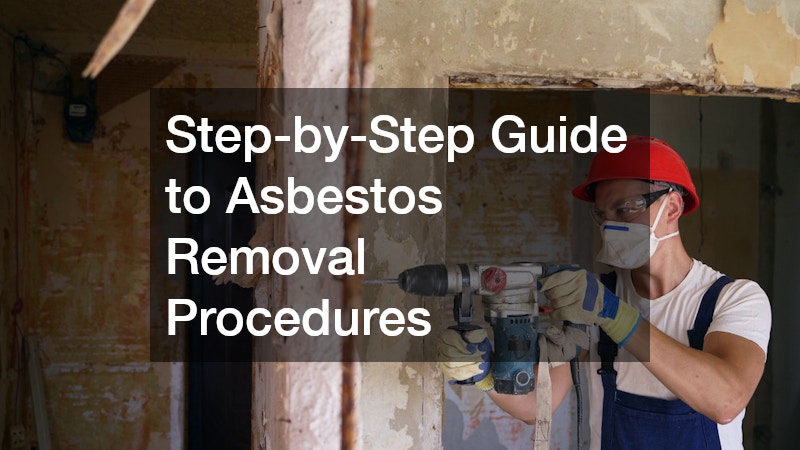Asbestos is a hazardous material that was widely used in Australian construction until the late 1980s due to its fire-resistant and insulating properties. However, once disturbed, asbestos fibres can become airborne and pose severe health risks, including mesothelioma, lung cancer and asbestosis. Because of these dangers, asbestos removal must be handled with care and in accordance with strict legal requirements.
This guide outlines the step-by-step procedures for safely removing asbestos from residential, commercial or industrial properties. Whether you’re a licensed professional or a property owner preparing for the process, understanding each phase ensures safety, compliance and peace of mind.
Step 1: Identify the Presence of Asbestos
The first step is to determine whether asbestos is present in the building. Asbestos can be found in roofing, fencing, eaves, vinyl floor tiles, insulation, wall sheeting, pipe lagging and even textured paint.
Since asbestos fibres are microscopic, a visual inspection is not enough. A National Association of Testing Authorities (NATA) accredited laboratory must analyse samples. Only a licensed asbestos assessor or competent person should collect these samples to avoid exposure and contamination.
Step 2: Risk Assessment & Control Plan
Once asbestos has been identified, a risk assessment must be carried out. This includes evaluating:
- The condition of the asbestos-containing materials (ACMs)
- The likelihood of fibre release
- The potential for human exposure
- Accessibility and proximity to occupied areas
Following the assessment, a removal control plan is developed. This document outlines how the removal will be carried out, including safety measures, personal protective equipment (PPE), containment methods and emergency procedures.
This plan must comply with the Model Code of Practice: How to Safely Remove Asbestos published by Safe Work Australia. If the work involves more than 10 square metres of non-friable asbestos, it must be undertaken by a licensed asbestos removalist.
Step 3: Notification & Clearance
Before any work begins, the relevant state or territory work health and safety regulator must be notified, usually five days before the scheduled removal date. Neighbours and other building occupants should also be informed to minimise risks and address concerns.
In some cases, such as friable asbestos removal, an independent licensed asbestos assessor must be present to monitor air quality and issue a clearance certificate upon completion.
Step 4: Site Preparation
Before removal begins, the site must be properly prepared:
- Restrict access to the area using signs, barricades and exclusion zones
- Shut down air-conditioning systems to prevent fibre spread
- Cover surfaces with plastic sheeting to catch debris
- Install decontamination units if required
All workers must wear appropriate PPE, including disposable coveralls, gloves and P2 respirators. A buddy system is also recommended to ensure compliance with safety procedures.
Step 5: Safe Removal of Asbestos
The actual asbestos removal service process varies depending on the type and condition of the ACMs. Friable asbestos (which crumbles easily) requires more stringent controls, such as negative pressure enclosures and specialised vacuum equipment.
Key safety measures include:
- Wetting the materials to suppress dust
- Using hand tools rather than power tools to reduce disturbance
- Avoiding breakage to limit fibre release
- Sealing removed materials in clearly labelled, double-lined containers
Step 6: Clean-Up & Decontamination
After the ACMs are removed, the area must be thoroughly cleaned using HEPA-filtered vacuums and wet wiping methods. Dry sweeping and compressed air are strictly prohibited.
Workers must pass through a decontamination process, including removing PPE and showering if facilities are available. All waste materials, including used PPE and disposable equipment, must be sealed and labelled before being transported to a licensed asbestos disposal facility.
A licensed asbestos assessor will conduct a final inspection, including air monitoring, before issuing a clearance certificate confirming the site is safe to reoccupy.
Step 7: Waste Disposal
Asbestos waste must be transported in sealed, leak-proof containers to an approved disposal site. All documentation, including waste transport certificates, must be retained for legal compliance.
Disposing of asbestos in household bins or illegal dumping can result in hefty fines and criminal charges. Only licensed waste transporters should handle the disposal.
Step 8: Post-Removal Monitoring
Even after a successful removal, ongoing monitoring may be required in workplaces or large-scale projects. This includes regular inspections, air testing and updating the asbestos register.
Building owners must keep records of the removal, including reports, clearance certificates and waste documentation. These records should be accessible for future renovations, sales or tenant agreements.
Safety Is Non-Negotiable

Removing asbestos is a high-risk activity that must be handled professionally and according to Australian regulations. Attempting DIY removal without a licence is not only illegal but also puts lives at risk. Always consult a licensed asbestos specialist and follow safe work practices from start to finish.
With the correct procedures, thorough planning and professional oversight, you can protect your health and ensure your property remains safe for years to come.


